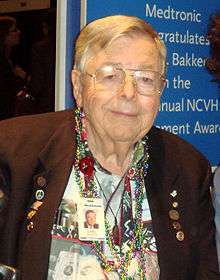Earl Bakken
| Earl Bakken | |
|---|---|
 | |
| Born |
January 10, 1924 Columbia Heights, Minnesota |
| Residence | Hawaii |
| Nationality | American |
| Alma mater | University of Minnesota |
| Occupation | inventor |
| Known for | founding Medtronic, inventing the wearable portable pacemaker, founding Bakken Museum |
Earl E. Bakken (born January 10, 1924 in Hennepin County, Minnesota) is an American engineer, businessman and philanthropist of Dutch and Norwegian American ancestry. He founded Medtronic, where he developed the first external, battery-operated, transistorized, wearable artificial pacemaker in 1957.[1]
Born in Columbia Heights, Minnesota, Bakken had a long-held fascination with electricity and electronics. A self-described "nerd", Bakken designed a rudimentary electroshock weapon in school to fend off bullies. After earning a Bachelor of Science in Electrical Engineering in 1948, he studied electrical engineering with a minor in mathematics at the University of Minnesota Graduate School. Post-World War II hospitals were just starting to employ electronic equipment, but did not have staff to maintain and repair them. Sensing an opportunity, with his brother-in-law, Palmer Hermundslie, he formed Medtronic (the combination of "medical" and "electronic") in a small garage, primarily working with the University of Minnesota hospital.
In the 1950s, Dr. C. Walton Lillehei was performing life-saving surgery on children with blue baby syndrome. That surgery often left the children needing to be temporarily attached to a pacemaker. The pacemakers at the time were large devices that required their own carts and relied on wall current for power. As a result of a power blackout on October 31, 1957, one of Dr. Lillehei's young patients died. Dr. Lillehei, who had worked with Bakken before, asked him the next day if he could solve the problem. Four weeks after finding a circuit diagram for a metronome in Popular Electronics, Bakken delivered a battery-powered transistorized pacemaker about the size of a few decks of cards to Dr. Lillehei. After successfully testing the hand-made device in the laboratory, Bakken returned to create a refined model for patients. However, much to his astonishment, when he came in the next day, he found the pacemaker already in use on a patient. (The Food and Drug Administration did not start regulating medical devices until 1976.)
Over the next several years, Bakken and Medtronic worked with other doctors to develop fully implantable pacemakers, but they also veered toward bankruptcy. He borrowed money that kept Medtronic going, but the bankruptcy near-miss drove Bakken to develop the Medtronic Mission, which still guides the company.[2] The mission helped the young company to stay focused on areas where it could truly help patients.
Bakken retired from Medtronic in 1989 and moved to a 9-acre estate in the Kona District of Hawaii he calls Bakken Hale,[3] but still returns to the company several times a year to meet new employees and explain the Medtronic Mission to them in person.
In 1996 he helped to dedicate the North Hawaii Community Hospital and has been active there ever since, working to combine Eastern and Western approaches to medicine to develop a more holistic approach to health care.[4]
See also
References
- ↑ Hebrew University of Jerusalem Institute of Chemistry: Earl E. Bakken
- ↑ Medtronic's Patient-Focussed Mission medtronic.com
- ↑ Mykleseth, Kathryn. "Supersize solar setup underway on Big Isle". http://www.fbactinsider.org. The Honolulu Star-Advertiser. Retrieved 12 January 2015. External link in
|website=(help) - ↑ "Ability Magazine: Earl Bakken Interview with Chet Cooper" (2009)". Retrieved 2012-04-03.
External links
- Earl Bakken's Website
- The Bakken Museum Homepage
- Works by or about Earl Bakken in libraries (WorldCat catalog)
|